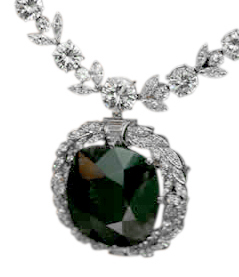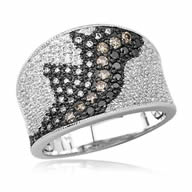Black Diamond: Paradox of a Gem
 Black diamonds don't do what diamonds should do.
Black diamonds don't do what diamonds should do.
A quality diamond sparkles, its facets refracting light, playing with its colors, and bouncing it back to the eye. But black absorbs light, so even expert diamond faceting fails at its most important job. And clarity doesn't much matter because a black stone is often opaque. Yet black diamond is a fashion star.
Fashion trends are mysterious. Black diamonds have only recently become popular in jewelry, though there are rare and beautiful collector's pieces.
 |
Black Orlov Diamond |
The 195-carat Black Orlov is a famous example. Also known as “The Eye of Brahma,” the stone is believed to be haunted by a curse since it was removed from a Hindu shrine in India. The curse seems to have reversed itself, however, after it was recut. The much smaller 67.5 carat Black Orvlov sold at auction in 1990 for $99,000; then, just five years later, it's price jumped to $1.5 million—certainly a stroke of good fortune for the seller.
A few other blacks are noted for their size and rarity. But in general, dark diamonds—black, brown, gray—were not considered attractive enough for jewelry. Another problem was that their color usually resulted from inclusions, which made the stones fracture easily during cutting. Most black diamond was relegated to industrial use as abrasives.
This all changed within the past decade, under the influence of Italian jewelry designers—and technology. Today, almost all black diamonds get their color from irradiation or other treatments. Natural black diamonds are found in only a few mines, so their quantity is limited. But treated blacks are turned out commercially, primarily from India, in almost unlimited quantities.
 |
Band with black and |
Designers have taken advantage of the drama of black, combined with the allure of diamond. Often they use small black diamonds along with white or yellow diamonds, to enhance the brightness of the light stones and the richness of the dark ones. Some retailers say men's wedding bands set with black diamonds are big sellers because black is regarded as a man's color. And there are jewelry retail web sites that specialize in black diamonds.
Diamond is a magic word for many people but “diamond” does not necessarily equal “valuable.”
- An irradiated black diamond has only a tenth the value of a good quality white diamond.
- Black diamonds can easily conceal flaws that would be apparent to the naked eye in a white diamond. Flaws such as inclusions can weaken the stone and make it more likely to damage.
- Black diamonds may be synthetic, as mined black diamonds of quality are quite rare.
FOR AGENTS & UNDERWRITERS
Treatments, such as irradiation and HPHT (high pressure high temperature), should be mentioned on the appraisal. Since virtually all black diamonds today are treated, check the appraisal for this information.
Black diamonds in general have only a fraction of the value of white diamonds of similar quality. For this reason, it's important to have an appraisal from a knowledgeable and reliable jeweler/appraiser, preferably a Graduate Gemologist who is also a Certified Insurance Appraiser™.
The appraisal should state whether the stone is natural or synthetic. Synthetic gems are worth far less than their natural counterparts.
For high-quality jewelry, it's best to have a diamond report from a reliable lab, such as GIA, AGS or GCAL.
FOR ADJUSTERS
Black diamond is a comparative newcomer to the fashion stage, and fashions change. Valuation at time of loss may be very different from the original selling price if the gem goes out of fashion. Use the description of the jewelry to determine valuation and arrive at a settlement.
Comb the appraisal and other documents for words that mean synthetic, such as man-made or lab-grown. In the extremely rare case of a quality black diamond that is natural, the appraisal should specifically state that.
Almost all black diamonds sold today are irradiated and/or HTHP-treated. Look for words that signify these treatments.
©2009, JCRS Inland Marine Solutions, Inc. All Rights Reserved. www.jcrs.com
©2000-2025, JCRS Inland Marine Solutions, Inc. All Rights Reserved. www.jcrs.com

